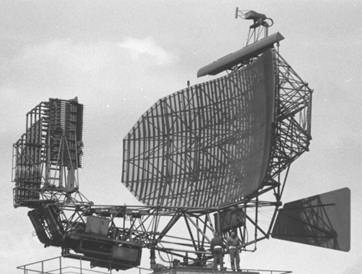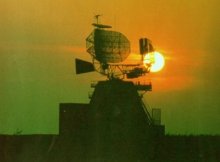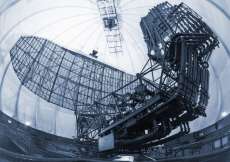MPR
Description of the radar set, tactical-technical characteristics

Figure 1: Antenna of MPR without radome
| Specifications | |
|---|---|
| frequency: | E/F-Band |
| pulse repetition time (PRT): | 4 ms |
| pulse repetition frequency (PRF): | 250 pps |
| pulsewidth (τ): | 4 µs |
| receive time: | 3132 µs |
| dead time: | 800 µs |
| peak power: | up to 20 MW |
| average power: | up to 40 kW |
| instrumented range: | 480 km |
| range resolution: | 600 m |
| accuracy: | |
| beamwidth: | 0.45° |
| hits per scan: | 3 |
| antenna rotation: | 6 rpm |
| MTBCF: | |
| MTTR: | |
MPR
The MPR (Medium Power Radar, designated by its manufacturer as TRS 2201) was installed in Germany during 1969 to 1973. Manufacturer was Thomson CSF (France) using modules from AEG Telefunken and Siemens. It was in service to 2013 - 2015 and will be replaced by the Ground Master 403 (GM 403).
In 1979 was retrofitted: a Digital ECM-system and a radome. In 1982 was carried out an exchange of traveling wave tubes to solid-state RF preamplifiers.
The MPR is a fixed radar. The components are housed in a multi-storey building. All installed in Germany six devices were identical in the version using two transmitters.
A pulsed high power klystron produces a maximum output power of 20 MW in E/F-Band This transmitter output stage is driven by a Carcinotron via two amplifier stages.
The transmitters pulse is splitted to a number of 34 feed horns in the antenna and then emitted. In each of the 34 feed horns there is a polarizer. This allows a linear, right or left circular polarization of the transmitted energy. The transmit pulse is emitted in a cosecant²- antenna pattern. In the receiving time, several feed horns are summarized and it is formed a stacked beam pattern consisting of 12 narrow beams. The sum of the 12 beams also yields a cosecant²- antenna pattern. These 12 beams are processed in independent receivers. In this manner one gets in addition to the azimuth and range data still an elevation angle information.
The receivers operate on the principle of double superheterodyne. The first intermediate frequency (IF) is 150 MHz, and the second IF is 30 MHz. Only the lower four channels are equipped with low-noise RF amplifiers. The slip-ring unit transfers only the second IFs from the antenna to the radar To protect against interference is used the “Dicke Fix”- processing into the IF-amplifier stage.
A 13th channel (SLB) serves to suppress unwanted side-lobes of the antenna. It uses the feed horn on the top of the parabolic reflector.
In the receiver, the signal is processed in two parallel signal paths:
- the CFAR path including interference suppression, and
- the log path with the true amplitude of the echo signals.
After an analog/digital conversion the target data is forwarded to the radar data processor.
PS-66
The radar was called in Sweden PS-66. Transmitter and receiver were identical but the indicator group was French original.
Picture gallery of MPR

Figure 4: The MPR was called PS-66 in Sweden,
© Gotlands Försvarshistoria och Gotlands Trupper,
www.tjelvar.se


